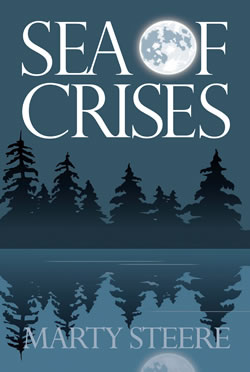Extras

Almost a third of the action in Sea of Crises takes place on the surface of the moon in September 1976. Curious readers have asked some interesting questions about the mission and some of the events that transpire. While I’ll be the first to disclaim a great expertise in space exploration - let’s face it, I’m no rocket scientist! - I did perform quite a bit of research in order to give the story a reasonable patina of accuracy and to fold the book’s fictional elements into existing history in a way that makes them believable without losing the excitement and novelty. So, I’ll repeat the questions here and give my responses.
Note that some of the questions involve spoilers. Those questions and answers can be accessed here.
Was there really an Apollo 18?
No. At least not one that ever lifted off. There were, however, plans for an Apollo 18 mission. It was one of three scheduled missions that never took place, victims of budget cutting in the early 1970s.
Originally, Apollo 18 was to be launched in February 1972, with a landing planned in Schröter's Valley, a long snaking depression in the moon’s surface most likely formed by volcanic activity. NASA subsequently pushed the anticipated launch date back to July 1973 and switched the proposed landing site to Gassendi, a large crater at the northern edge of the Mare Humorum, the Sea of Moisture.
In January 1970, the first of the cancellations eliminated what would have been the last of the Apollo missions, Apollo 20. (The Saturn V rocket scheduled to be used on that mission was re-designated as the launch vehicle for the Skylab space station.) Then, in September of that same year, two more missions, Apollo 15 and Apollo 19, were given the ax. The remaining missions were re-numbered, resulting in the loss of the anticipated Apollo 18 mission and leaving Apollo 17 in December 1972 the last manned lunar exploration.
Based on the way astronaut crew assignments were generally being made by NASA, it is likely that the real Apollo 18 would have been commanded by Richard “Dick” Gordon, who was a veteran of both the Gemini and Apollo programs, having flown with his friend Pete Conrad on Gemini 11 and having served as the command module pilot on Apollo 15, while Conrad, as commander, and Alan Bean, as lunar module pilot, explored the Oceanus Procellarum, the Ocean of Storms.
The other crew spots on Apollo 18 would likely have been filled by Vance Brand, as command module pilot, and Harrison “Jack” Schmitt, as lunar module pilot.
Brand went on to serve as Apollo command module pilot on the Apollo-Soyuz project, a joint U.S.-Soviet mission in which an Apollo capsule and a Soyuz spacecraft made the first international space rendezvous in July 1975. (The module used on Apollo-Soyuz was CSM-111, which is the command module that would have been used on the original Apollo 15 but for that mission’s cancellation.) Some have referred to the U.S. portion of the Apollo-Soyuz mission informally as “Apollo 18,” but that is not the official - or common - designation. Brand subsequently commanded three shuttle missions in 1982, 1984 and 1990.
Schmitt, who was a geologist, is the only professional scientist to ever walk on the moon. When Apollo 18 was cancelled, he was moved up to fill the position of lunar module pilot on Apollo 17, and he became the twelfth, and last, man to set foot on the moon (in the Taurus-Littrow Valley with commander Eugene “Gene” Cernan).
Gordon retired from NASA and the U.S. Navy in January 1972, and he became Executive Vice President of the New Orleans Saints. Schmitt resigned from NASA in August 1975 to run for senator from New Mexico, and he served in the United States Senate from 1976 to 1982. Consequently, neither would have been around to man an Apollo 18 when, according to the narrative in Sea of Crises, the program was suddenly revived for one additional mission. Brand, of course, would have still been attached to NASA and available, but he had just flown the prior year in Apollo-Soyuz.
For additional questions and answers that contain “spoilers,” click here.